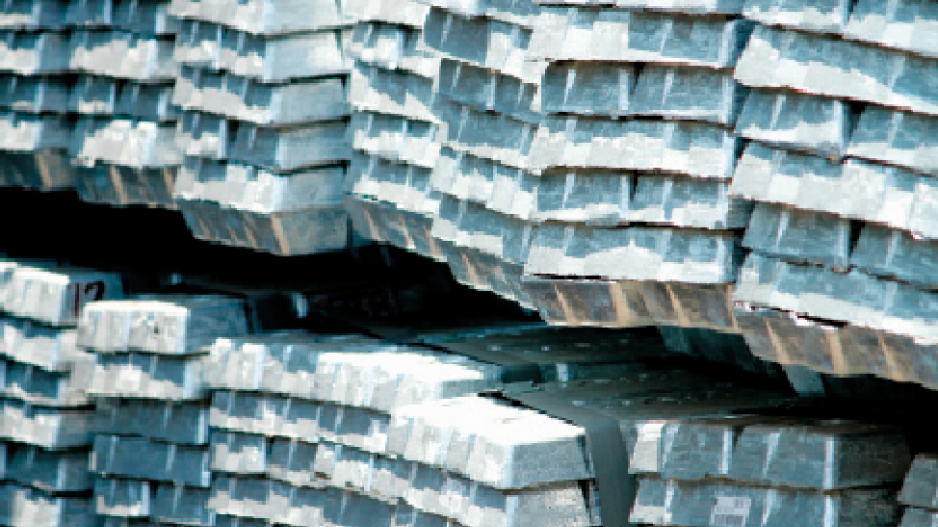The shine is off gold, metallurgical coal’s prospects are black for at least another year, and molybdenum has suddenly lost its strength.
Is there no good news for B.C.’s mining and exploration sector?
Actually, there is. That one flash of light on an otherwise overcast horizon is coming off of zinc.
It’s one base metal that Scotiabank economist Patricia Mohr is particularly bullish on – that and nickel.
A handful of zinc mines around the world are being depleted, leading to mine closures or imminent closures. Moreover, Scotiabank predicts an increasing demand for zinc in galvanized steel used by automakers in China.
Zinc, which sold for US$2 per pound in 2007, dropped as low as US$0.50 per pound in 2009. The price has rebounded since then, hitting US$0.96 per pound on December 17, 2014, and Mohr is predicting it will rise to between US$1.60 and US$1.70 per pound in 2016 and 2017.
“Probably the market for zinc concentrate is going to shift into a deficit situation by 2016,” Mohr said. “Commodity funds and institutional investors have noticed this and they’ve started to take positions in zinc.”
Rising zinc prices could help offset the pummelling companies such as Teck Resources Ltd. (TSX:TCK.B) have taken on the metallurgical coal side of their business.
Teck operates a zinc and lead smelter in Trail, B.C., and just recently restarted its Pend Oreille zinc-lead mine in Washington state. It made its first shipment of zinc oxide in December.
That may help explain why Teck’s stock, which lost 51% of its value between the end of July and mid-December, bounced 21% from the December 12, 2014, price of $12.82 per share to $15.57 on December 23, 2014. Zinc is also helping to buoy the Myra Falls mine on Vancouver Island. Its main product is zinc, although it also produces lead, copper, gold and silver.
Mohr believes rising prices could fuel increased exploration and development in B.C., the Yukon and Northwest Territories for deposits containing zinc.
“I think the interest in the zinc projects is going to intensify for the next several years,” she said.
One new potential mine in B.C. is the Ruddock Creek zinc-lead deposit. Imperial Metals (TSX:III) wants to develop an underground zinc-lead mine north of Adams Lake. The proposed Chieftain Metals Corp. (TSX:CFB) Tulsequah Chief mine near Atlin also contains zinc.
Apart from zinc, B.C.’s main mining commodities – gold, copper and metallurgical coal – don’t appear to be on their way up in price any time soon.
Copper prices have remained relatively stable for the past three years, but Scotiabank predicts they will dip slightly in 2015 to an average price of about $3 per pound.
“It’s still at profitable levels, but there’s still new supplies coming on stream around the world in copper,” Mohr said.
Flat copper prices have not deterred Seabridge Gold Inc. (TSX:SEA), which is planning a $5.3 billion gold-copper-silver-molybdenum mine northwest of Stewart, B.C.
The KSM project is said to be the largest undeveloped copper deposit in the world. It cleared a major hurdle in December when it was granted a Canadian Environmental Assessment Agency certificate.
By the time construction starts on the mine, prices for many commodities are expected to have rebounded.
“You’ve got economies around the world that are growing and populations that are growing and the demand for metals and minerals for things like cars and electronics is growing,” said PwC managing partner John DeLucchi. “I think we’re in a good position, but it’s just this next year to year and a half that we’ve got to kind of ride it out a little bit.”
A global glut of metallurgical coal – B.C.’s second-largest export – has brought prices down from US$300 per tonne in 2011 to US$117 per tonne. Prices are not expected to recover for at least 12 months, according to coal industry experts.
The same problem has hit another mineral mined in B.C. – molybdenum, which is used to harden steel. In December, Thompson Creek Metals Co. Inc. (TSX:TCM) announced it will idle its Endako molybdenum mine in Fraser Lake in the new year.
Like met coal, there is a global glut of moly, which has pushed prices from about $17 per pound in 2010 to $8.77 per pound in December 2014.
Despite the current low prices for molybdenum, Avanti Mining Inc. – which recently changed its name to Alloycorp Mining Inc. (TSX:AVT) – continues to push ahead with plans to reopen the Kitsault molybdenum mine. In July, the company announced it had signed a US$612 million debt financing deal to develop the mine.
As for gold, a strengthening U.S. economy and dollar mean prices are likely to stay flat or inch down in 2015, Mohr said. BMO Capital Markets chief economist Doug Porter agrees.
In a recent Gold Report, he said he expects gold prices in 2015 to be in the US$1,190-per-ounce range. He also expects to see a number of mergers and acquisitions among smaller and intermediate gold miners.
As for capital markets, a flight of investment out of mining stock has hurt junior miners the most. Fortunately for B.C., several mines were already in the late development stage when investment capital started going south.
The completion of the Northwest Transmission Line last year is also expected to be a catalyst for new mine development in the golden triangle of northwest B.C.
“A lot of advanced projects in British Columbia that are base-metal-focused and precious-metal-focused are doing very well and continue to attract investment and continue to advance their project,” said Gavin Dirom, CEO of the Association for Mineral Exploration BC.




